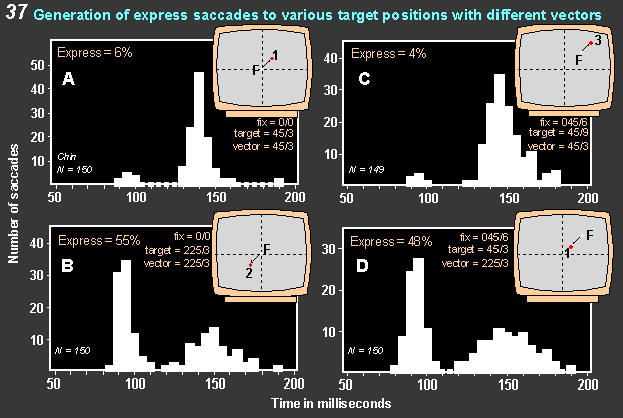The Neural
Control of Visually Guided Eye Movements
D. Temporal Factors in Visually Guided Saccadic Eye Movements
1. The conditions under which express
saccades can and cannot be generated.
h. Is the production of express saccades contingent
on the position of the targets in space, on the orbital position of the
eye or on the saccadic vector generated?
 Two
experiments were conducted to answer this questions. In the first, targets
were placed at set locations on the monitor and the fixation spot was
moved to selected sites enabling us to determine whether express saccades
generation depends on the position of the target in space or on the vector
of the saccades produced. This animal, as shown in Figure
37A, made few express saccades to a target at 45/3 that required
a 45/3 saccadic vector. By contrast, as shown in Figure
37B, many express saccades were made to a target at 225/3
that required a vector of 225/3. This was the animal's natural disposition.
When the fixation spot was moved to 45/6 and the target to 45/9, which
generated the same saccadic vector of 45/3 as in Figure
37A, few express saccades were made; this is shown in Figure
37C. On the other hand, as shown in Figure
37D, many express saccades were generated to the target at
45/3 that necessitated a saccadic vector of 225/3. The target in Figure
37D is in the same position as in Figure
37A. The findings suggest that the crucial factor in express
saccade generation is the saccadic vector, not the position of the target
in space. Two
experiments were conducted to answer this questions. In the first, targets
were placed at set locations on the monitor and the fixation spot was
moved to selected sites enabling us to determine whether express saccades
generation depends on the position of the target in space or on the vector
of the saccades produced. This animal, as shown in Figure
37A, made few express saccades to a target at 45/3 that required
a 45/3 saccadic vector. By contrast, as shown in Figure
37B, many express saccades were made to a target at 225/3
that required a vector of 225/3. This was the animal's natural disposition.
When the fixation spot was moved to 45/6 and the target to 45/9, which
generated the same saccadic vector of 45/3 as in Figure
37A, few express saccades were made; this is shown in Figure
37C. On the other hand, as shown in Figure
37D, many express saccades were generated to the target at
45/3 that necessitated a saccadic vector of 225/3. The target in Figure
37D is in the same position as in Figure
37A. The findings suggest that the crucial factor in express
saccade generation is the saccadic vector, not the position of the target
in space.
|